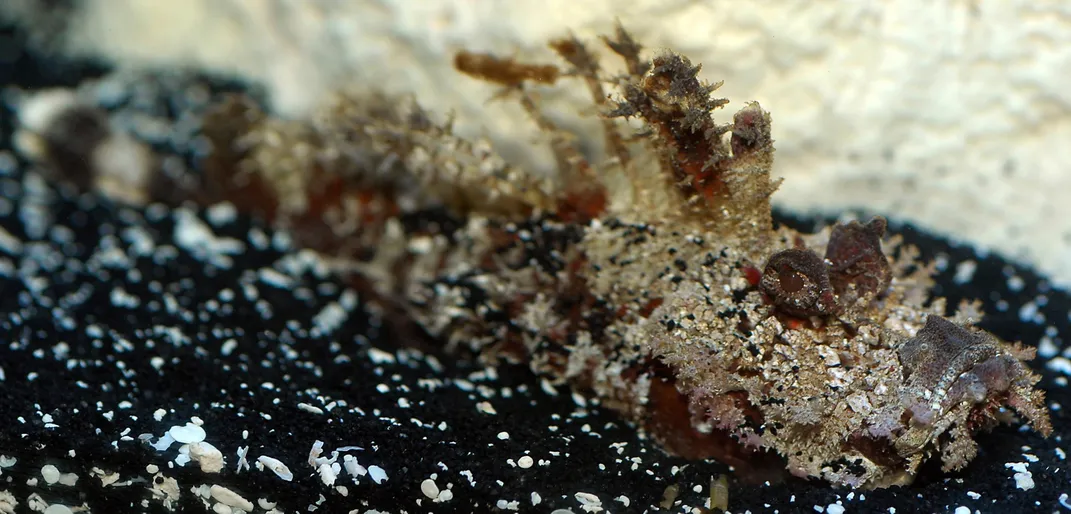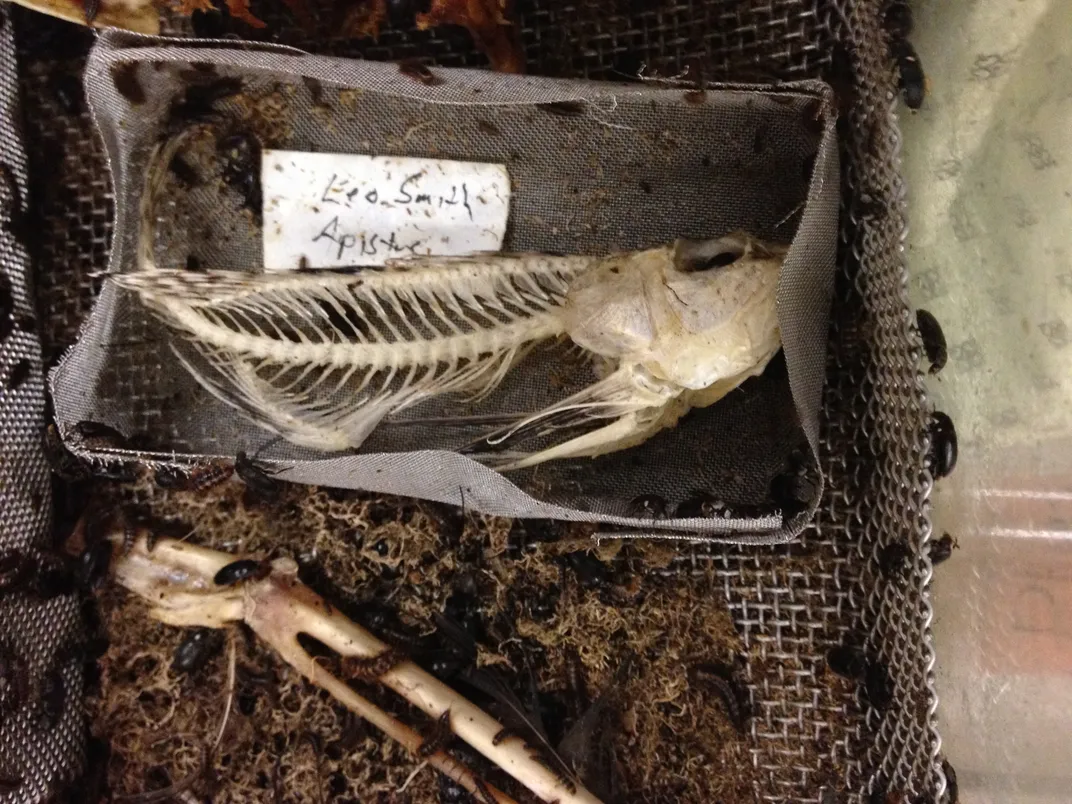Why Did a Venomous Fish Evolve a Glowing Eye Spike?
A newly discovered “lachrymal saber” could illuminate relationships between an order of deadly fishes
/https://tf-cmsv2-smithsonianmag-media.s3.amazonaws.com/filer/cd/b4/cdb40432-adf3-4deb-aef2-36f1c084943f/prowfish-wr.jpg)
In 2003, Leo Smith was dissecting a velvetfish. Smith, an evolutionary biologist at the University of Kansas, was trying to figure out the relationships between mail-cheeked fishes, an order that includes velvetfishes, as well as waspfishes, stonefishes and the infamous lionfish. As he worked his way to the velvetfish's upper jaw, though, he realized something strange—he was having trouble removing the lachrymal bone.
“On a normal fish, there's a little bit of connective tissue and you can work a scalpel blade between the upper jaw and this bone,” recalls Smith, whose work centers on the evolution of fish venom and bioluminescence. “I was having just a horrible time trying to separate it. When I finally got it separated, I noticed there was this thing that's all lumpy and bumpy … it was then that it hit me that it had to be some sort of locking mechanism.”
To be fair, most velvet fish already resemble thorny, blobby mutants, so an extra skewer isn’t really that unusual. But given that Smith has spent years studying mail-cheeked fishes (Scorpaeniformes)—an order that gets its common name from the bone plates found on each cheek—you’d think he would have noticed a massive, locking eye spike before. He hadn’t. He and his colleagues would dub this strange new discovery the “lachrymal saber.”
(FYI: Lachrymal comes from the Latin word for “tear.” While fish can’t cry, it’s still the technical name for the bone forming the eye socket.)
Smith and his co-authors at the American Society of Ichthyologists and Herpetologists describe this unlikely eye spike for the first time in the journal Copeia—and even report on one that glows fluorescent green, a little eye lightsaber. The authors can’t yet say exactly what the appendage is for. But they do claim that it has the potential to profoundly rearrange the Scorpaeniformes evolutionary tree, changing what we know about these highly venomous fish.
The finding also raises the question: How the heck did a glowing, locking sword-like appendage go ignored for so long?

It’s easy to miss a stonefish. True to their name, they closely resemble rocks, with cobbled-covered exteriors that mirror underwater rubble or chunks of coral. But step on one, and you’ll never forget it.
There are more venomous fish in the seas than snakes on land—or indeed, than all venomous vertebrates combined—but the stonefish is one of the most venomous on the planet. Getting pricked by one of these marine monsters can feel, as an unlucky victim once put it, like “hitting your toe with a hammer and then rubbing over it again and again with a nail file." While it’s uncommon, divers have even died after such an encounter.
Stonefish and their cousins are also marvelous at camouflage. Some grow algae and hydroid gardens on their backs, others can change color at will, and one, the decoy scorpionfish, has a lure on its dorsal fin that resembles a tiny, swimming fish. Found mainly in the tropical waters throughout the Indo-Pacific, these remarkable creatures use their disguises to both ambush prey and avoid becoming lunch themselves.
But the lachrymal saber, a unique aspect of these fish, had somehow gone overlooked. And while it’s not a Star Wars lightsaber or a blade from Lord of the Rings, this saber might be something even more impressive. Picture a complex spine under the fish’s eye that operates like a ratchet and pawl, laterally locking into place like two sharp arms. “They don't actually even move the saber itself,” says Smith. “They move the underlying bone that's connected to it through the locking mechanism and then that rotation is what locks it out.”
In at least one species—Centropogon australis, a breed of waspfish—the saber glows a biofluorescent lime green, while the rest of the fish glows orange-red under certain light.
Adam Summers, a biomechanist and fish specialist at the University of Washington, is currently trying to CT scan all 40,000 species of fish. Summers, who was not involved in the recent study, has already scanned 3052 species and 6,077 specimens, while studying many mail-cheeked fishes for years. And he’s never noticed the saber.
“Erectile defenses in fishes are really common,” says Summers, who was also a scientific consultant on Pixar’s Finding Nemo and Finding Dory. He isn’t referring to fish penises, but anatomical defenses that pop up when certain species are stressed or threatened. “If you’ve ever caught a fish and tried to pull it off the hook, you know the dorsal spines erect and they can poke the living crap out of you," hes says, "but that we missed one that was under the eye—sort of an eye saber—is pretty insane.”
To determine that these fish really are related beyond the saber, the researchers in the new study used DNA sequencing to confirm their findings. Looking at 5,280 aligned nucleotides and using 12 outgroups as controls, they built a phylogenetic or evolutionary tree. Once you have the tree, Smith explains, there are methods called ancestral character state reconstruction that allow us to trace when characters evolve. And that may help biologists unify a group of fishes that was previously thought to be separate families.
“The taxonomy of Scorpaeniformes is historically muddled,” Smith explains. “The scorpionfish and stonefish relationships have been really problematic, and there have been a lot of family-level names attached to this group that are dramatically cleaned up when these groups are treated as the two main lineages rather than the 10 traditional families. It is much cleaner now and the presence of a lachrymal saber can separate the two revised families completely.”

When he was first dissecting the velvetfish, Smith didn’t understand what he was looking at. “I just thought they were kind of spinier or lumpier,” he says. “These fish have a lot of spines and bumps on their head. So I was like, ‘Oh, these [lachrymal] ones are kind of more interesting.’”
Smith spent years examining fish skeletons and live fish to determine how widespread this saber was. Fortunately, as a curator at the Biodiversity Institute at the University of Kansas, he has access to one of the largest libraries of fish specimens in the world.
Many of these exemplar fish were made using a method called “clearing and staining,” in which scientists use a mix of liquid formaldehyde and a stomach enzyme called trypsin to dissolve muscle and other soft tissue. The result is a clear skeleton with red-tinted bones and blue-colored cartilage, like stained glass. This technique makes it easy to study skeletal structures of vertebrates.
“People who study fishes closely often work with dead preserved fish and these kinds of really cool things don't work in an animal that isn’t mobile,” says Summers. Still, “to find this and then to realize that it’s an uniting character for a whole group of fishes is very, very cool.”
Smith isn’t sure why the fish evolved this trait. The obvious assumption is it’s defensive, given the projected spines expand the width of the head, making the fish harder to swallow and more likely to puncture a would-be predator. Similar defensive measures exist: the deep-sea lanternshark, for example, has glowing “lightsabers” on its dorsal spine that are believed to defend against predators. But Smith hasn’t seen the lachrymal saber used defensively, except in photographs of mail-cheeked fishes getting eaten.
“I went into this assuming it was an anti-predator, complex anatomical thing that grew that way and now as every day goes on, I start questioning that more and more,” Smith says. “Part of it is I can never get the stupid things to do it … I mean you would think if it was just anti-predator, if I bumped the tank they would immediately get them out.” The other option, he says, is that it might be for attracting mates, though he points out that both genders appear to have the sabers.
In other words, for now, the eye spike is still a mystery.
In 2006, with Ward Wheeler, Smith found that more than 1200 species of fish are venomous, compared to previous estimates of 200. He updated that number a decade later to between 2386 and 2962. He also worked on a PLOS One paper with noted ichthyologists Matt Davis and John Sparks to show that bioluminescence evolved 27 separate times in marine fish lineages. He even revised the taxonomy of butterflyfishes.
With this new finding, Smith may have disrupted the way we think about fish relationships yet again, says Sarah Gibson, an adjunct professor of biology at St. Cloud State University in Minnesota who studies Triassic fish. “I think it's a pretty important, big study,” she says. “Knowing the evolutionary relationships of a group can really impact our understanding of the evolutionary history of fishes in general.” (Gibson worked with Smith when she was doing her dissertation, but was not part of the recent study.)
Understanding the evolution of stonefish is key to their conservation, adds Summers. “You can't conserve something unless you know who it is,” he says. The mystery of the lachrymal saber “is an interesting question that's worth addressing and I’m still blown away that we missed it.”
In the end, this discovery also underscores something Smith once told The New York Times: Despite centuries of research and exploration, “we really don’t know anything about fish.”